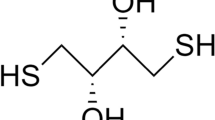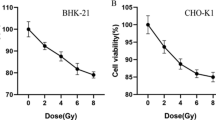Abstract
Ultraviolet B (UVB medium wave, 280–315 nm) induces cellular oxidative damage and apoptosis by producing reactive oxygen species (ROS). Glutathione peroxidase functions as an antioxidant by catalyzing the reduction of hydrogen peroxide, the more important member of reactive oxygen species. A human selenium-containing single-chain variable fragment (se-scFv-B3) with glutathione peroxidase activity of 1288 U/μmol was generated and investigated for its antioxidant effects in UVB-induced oxidative damage model. In particular, cell viability, lipid peroxidation extent, cell apoptosis, the change of mitochondrial membrane potential, caspase-3 activity and the levels of intracellular reactive oxygen species were assayed. Human se-scFv-B3 protects NIH3T3 cells against ultraviolet B-induced oxidative damage and subsequent apoptosis by prevention of lipid peroxidation, inhibition of the collapse of mitochondrial membrane potential as well as the suppression of the caspase-3 activity and the level of intracellular ROS. It seems that antioxidant effects of human se-scFv-B3 are mainly associated with its capability to scavenge reactive oxygen species, which is similar to that of the natural glutathione peroxidase.
Similar content being viewed by others
Abbreviations
- ROS:
-
reactive oxygen species
- H2O2 :
-
hydrogen peroxide
- GPX:
-
Glutathione peroxidase
- UVB:
-
ultraviolet B
- se-scFv:
-
selenium-containing single-chain variable fragment
- MDA:
-
malondialdehyde
- DiOC6(3):
-
3,3-dihexyloxacarbocyanine iodide
- MTT:
-
3-(4,5-dimethylthiazol-2-yl)-2,5-diphenyltetrazolium bromide
- ΔΨm :
-
mitochondrial membrane potential
References
Castro L., Freeman B.A. 2001. Reactive oxygen species in human health and disease. Nutrition. 17, 161–165.
Michies C., Raes M., Toussaaint O., Remacle J. 1994. Importance of Se-glutathione peroxidase, catalase, and Cu/Zn-SOD for cell survival against oxidative stress. Free Rad. Biol. Med. 17, 235–248.
Jiang Z.H., Mu Y., Li W.J., Yan G.L., Luo G.M. 2002. The progress in mechanism of selenoprotein biosynthesis. Acta Biochim. Biophys. Sin. 34, 395–399.
Davis R.L., Lavine C.L., Arredondo M.A., McMahon P., Tenner T.E., Jr. 2002. Differential indicators of diabetes- induced oxidative stress in New Zealand white rabbits: Role of dietary vitamin E supplementation. Int. J. Exp. Diabetes. Res. 3, 185–192.
Burke M.P., Opeskin K. 2002. Fulminant heart failure due to selenium deficiency cardiomyopathy (Keshan Disease). Med. Sci. Law. 42, 10–13.
Forgione M.A., Cap A., Liao R., Moldovan N.I., Eberhardt R.T., Lim C.C., Jones J., Goldschmidt-Clermont P.J., Loscalzo J. 2002. Heterozygous cellular glutathione peroxidase deficiency in the mouse: Abnormalities in vascular and cardiac function and structure. Circulation. 106, 1154–1158.
Babizhayev M.A. 1996. Failure to withstand oxidative stress induced by phospholipid hydroperoxides as a possible cause of the lens opacities in systemic diseases and ageing. Biochem. Biophys. Acta. 1315, 87–99.
Ramakrishnan N., Kalinich J.F., McClain D.E. 1996. Ebselen inhibition of apoptosis by reduction of peroxides. Biochem. Pharmacol. 51, 1443–1451.
Luo G.M., Zhu Z.Q., Ding L., Gao G., Sun Q.A., Liu Z., Yang T.S., Shen J.C. 1994. Generation of seleniumcontaining abzyme by chemical mutation. Biochem. Biophys. Res. Comm. 198, 1240–1247.
Su D., Ren X.J., You D.L., Li D., Mu Y., Yan G.L., Zhang Y., Luo Y.M., Xue Y., Shen J.C., Liu Z., Luo G.M. 2001. Generation of three selenium-containing catalytic antibodies with high catalytic efficiency using a novel hapten design method. Arch. Biochem. Biophys. 395, 177–184.
Ren X.J., Gao S.J., You D.L., Huang H.L., Liu Z., Mu Y., Liu J.Q., Zhang Y., Yan G.L., Luo G.M., Yang T.S., Shen J.C. 2001. Cloning and expression of a singlechain catalytic antibody that acts as a glutathione peroxidase mimic with high catalytic efficiency. Biochem. J. 359, 369–374.
Sun Y., Mu Y., Li W. J., Lv S.W., Jiang Z.H., Zhang K., Zheng K.Y., Lin F., Yan G.Y., Luo G.M., Liu J.Q., Shen J.C. 2003. Protection of epidermal cells against UVB injury by the antioxidant selenium-containing single-chain Fv catalytic antibody. Arch. Biochem. Biophys. 412, 90–94.
Huo R., Wei J.Y., Xu J.J., Lv S.W., Zheng Q.C., Yan F., Su J.M., Fan J., Li J.S., Duan Y.J., Yu Y., Jin F.H., Sun W.G., Shi Y., Cong D.L., Li W., Yan G.L., Luo G.M. 2008. Human catalytic antibody Se-scFv-B3 with high glutathione peroxidase activity. J. Mol. Recognit. 21, 324–329.
Huo R., Shi Y., Xu J.J., Yan F., Lv S.W., Su J.M., Duan Y.J., Fan J., Ning B., Cong D.L., Yan G.L., Luo G.M., Wei J.Y. 2009. Antioxidant effect of human selenium-containing single-chain Fv in rat cardiac myocytes. Chem. Res. Chinese Universities. 25, 216–219.
Sun Y., Mu Y., Ma S.M., Gong P.S., Yan G.L., Liu J.Q., Shen J.C., Luo G.M. 2005. The molecular mechanism of protecting cells against oxidative stress by 2-selenium-bridged beta-cyclodextrin with glutathione peroxidase activity. Biochim. Biophys. Acta. 1743, 199–204.
Huo R., Zhou Q.L., Wang B.X., Tashiro S.I., Onodera S., Ikejima T. 2004. Diosgenin induces apoptosis in HeLa cells via activation of caspase pathway. Acta. Pharmacologica. Sinica. 25, 1077–1082.
Ryoo Y.W., Suh S.I., Mun K.C., Kim B.C., Lee K.S. 2001. The effects of the melatonin on ultraviolet-B irradiated cultured dermal fibroblasts. J. Dermatol. Sci. 27, 162–169.
Fischer T.W., Scholz G., Knöll., Hipler U.C., Elsner P. 2001. Melatonin reduces UV-induced reactive oxygen species in a dose-dependent manner in IL-3-stimulated leukocytes. J. Pineal Res. 31, 39–45.
Moison R.M., Beijersbergen V., Henegouwen G.M. 2001. Dietary eicosapentaenoic acid prevents systemic immunosuppression in mice induced by UVB radiation. Radiat. Res. 156, 36–44.
Cordis G.A., Bagchi D., Maulik N., Das D.K. 1994. High-performance liquid chromatographic method for the simultaneous detection of malonaldehyde, acetaldehyde, formaldehyde, acetone and propionaldehyde to monitor the oxidative stress in heart. J. Chromatogr. A. 661, 181–191.
Kawazoe N., Watabe M., Masuda Y., Nakajo S., Nakayo K. 1999. Tiami1 is involved in the regulation of bufalin-induced apoptosis in human leukemia cells. Oncongene. 18, 2413–2421.
Fu J.J., Huang H.Q., Liu J.J., Pi R.B., Chen J.W., Liu P.Q. 2007. Tanshinone IIA protects cardiac myocytes against oxidative stress-triggered damage and apoptosis. Eur. J. Pharmacol. 568, 213–221.
Yin L., Han X., Yu Y., Guo X., Ren L.Q., Fang J.Q., Liu Z.Y., Yan G.L., Wei J.Y. 2012. Antioxidant effect of selenium-containing glutathione S-transferase in rat cardiomyocytes. Chem. Res. Chinese Univ. 28, 454–458.
Matsuda K., Yoshida K., Taya Y., Nakamura K., Nakamura Y., Arakawa H. 2002. p53AIP1 regulates the mitochondrial apoptotic pathway. Cancer. Res. 62, 2883–2889.
Petronilli V., Costantini P., Scorrano L., Colonna R., Passamonti S., Bernardi P. 1994. The voltage sensor of the mitochondrial permeability transition pore is tuned by the oxidation–reduction state of vicinal thiols: Increase of the gating potential by oxidants and its reversal by reducing agents. J. Biol. Chem. 269, 16638–16642.
Wu X.H., Cao S.G., Goh S., Hsu A., Tan B.K. 2002. Mitochondrial destabilisation and caspase-3 activation are involved in the apoptosis of Jurkat cells induced by gaudichaudione A, a cytotoxic xanthone. Planta Med. 68, 198–203.
Armstrong J.S. 2006. The role of the mitochondrial permeability transition in cell death. Mitochondrion. 6, 225–234.
Wolf B.B., Schulert M., Echeverri F., Green D.R. 1999. Caspase-3 is the primary activator of apoptotic DNA fragmentation via DNA fragmentation factor-45/inhibitor of caspase-activated DNase inactivation. J. Biol. Chem. 274, 30651–30656.
Cai L., Li W., Wang G., Guo L., Jiang Y., Kang Y.J. 2002. Hyperglycemia-induced apoptosis in mouse myocardium: Mitochondrial cytochrome c-mediated caspase-3 activation pathway. Diabetes. 51, 1938–1948.
Author information
Authors and Affiliations
Corresponding author
Additional information
Published in Russian in Molekulyarnaya Biologiya, 2017, Vol. 51, No. 3, pp. 483–489.
The article is published in the original.
Rights and permissions
About this article
Cite this article
Huo, R., Yang, L., Zhang, T.G. et al. Human selenium-containing single-chain variable fragment with glutathione peroxidase activity protects NIH3T3 fibroblast against oxidative damage. Mol Biol 51, 426–431 (2017). https://doi.org/10.1134/S0026893317030074
Received:
Revised:
Published:
Issue Date:
DOI: https://doi.org/10.1134/S0026893317030074




